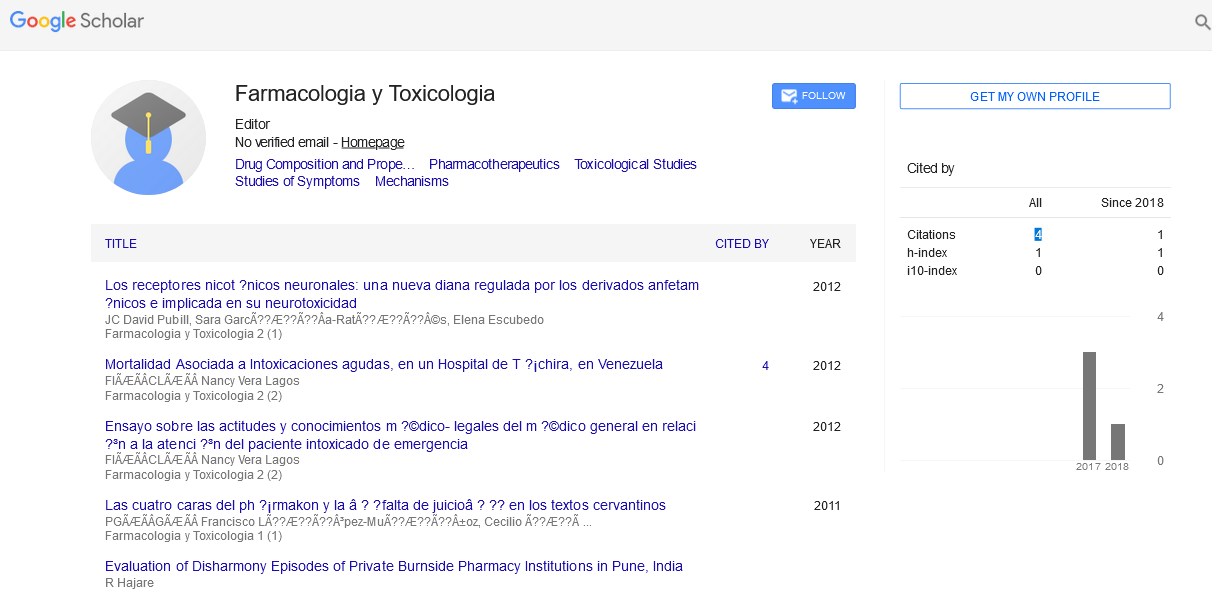Perspective - (2024) Volume 14, Issue 6
Acute Toxicity: Mechanisms, Measurement and Implications
Qing Xia*
Department of Pharmacokinetics, University of Shigekhan, Aichi, Japan
*Correspondence:
Qing Xia, Department of Pharmacokinetics, University of Shigekhan, Aichi,
Japan,
Email:
Received: 07-Aug-2024, Manuscript No. IPFT-24-15140;
Editor assigned: 12-Aug-2024, Pre QC No. IPFT-24-15140 (PQ);
Reviewed: 26-Aug-2024, QC No. IPFT-24-15140;
Revised: 02-Dec-2024, Manuscript No. IPFT-24-15140 (R);
Published:
30-Dec-2024
Introduction
Acute toxicity refers to the adverse effects that result from a
single exposure to a toxic substance or multiple exposures in a
short period, typically within 24 hours. This concept is
fundamental in toxicology and environmental science as it helps
determine the immediate risks posed by chemicals to human
health and the environment. Understanding acute toxicity is
crucial for developing safety guidelines, regulatory policies and
emergency response strategies.
Description
Mechanisms of acute toxicity
Acute toxicity occurs when a toxic substance enters the body
and interacts with biological systems, leading to harmful effects.
The severity and nature of these effects depend on several
factors, including the chemical properties of the substance, the
route of exposure and the biological characteristics of the
organism.
Routes of exposure: The primary routes through which toxic
substances can enter the body are inhalation, ingestion, dermal
absorption and injection. Each route has different implications
for how the substance is absorbed, distributed, metabolized and
excreted.
Absorption and distribution: Once a toxic substance enters
the body, it must be absorbed into the bloodstream to exert its
effects. The rate and extent of absorption depend on the
chemical nature of the substance and the route of exposure. For
instance, inhaled substances can rapidly enter the bloodstream
through the lungs, while ingested substances are absorbed more
slowly through the gastrointestinal tract. After absorption, the
substance is distributed throughout the body, with some tissues
accumulating higher concentrations than others.
Metabolism and excretion: The body’s ability to metabolize
and excrete toxic substances is a critical factor in determining
acute toxicity. Metabolism typically occurs in the liver, where
enzymes transform the substance into more water-soluble
compounds that can be excreted via urine or feces. However,
some substances are metabolized into more toxic forms,
increasing their harmful effects.
Measurement of acute toxicity
Quantifying acute toxicity involves determining the dose of a
substance that causes harmful effects in a specific time frame.
This measurement is critical for assessing the risks associated
with exposure and establishing safety standards.
LD50 and LC50: The median Lethal Dose (LD50) and median
Lethal Concentration (LC50) are commonly used metrics in acute
toxicity testing. LD50 represents the dose required to kill 50% of
a test population (usually rodents) within a specified period,
typically 24 hours. LC50 refers to the concentration of a
substance in air or water that kills 50% of the test population.
These values provide a standardized way to compare the acute
toxicity of different substances.
Test organisms: Acute toxicity tests are usually conducted on
animals, such as rats, mice or fish, because of their physiological
similarities to humans or their relevance to environmental risk
assessment. The choice of test organism depends on the
intended use of the data, such as human health risk assessment
or environmental impact evaluation.
Exposure methods: Test organisms can be exposed to toxic
substances through various methods, including oral gavage,
inhalation chambers or dermal application. The chosen method
should mimic the expected human or environmental exposure
route to provide relevant data.
Implications of acute toxicity
The understanding and assessment of acute toxicity have
significant implications for public health, environmental
protection and regulatory policies.
Public health: Acute toxicity data are essential for identifying
and managing the risks posed by chemicals to human health.
This information helps establish exposure limits, develop safety
guidelines and design emergency response plans. For example,
acute toxicity data are used to set occupational exposure limits
to protect workers from harmful chemicals in the workplace.
Environmental protection: Assessing the acute toxicity of
chemicals to wildlife is crucial for protecting ecosystems. This
information is used to develop environmental regulations, such
as permissible discharge limits for industrial effluents, to prevent
harm to aquatic and terrestrial organisms. Acute toxicity data
also help identify hazardous substances that require special handling and disposal procedures to minimize environmental
contamination.
Regulatory policies: Governments and regulatory agencies use
acute toxicity data to evaluate the safety of chemicals before
they are approved for use in consumer products,
pharmaceuticals and industrial processes. Regulatory
frameworks, such as the Toxic Substances Control Act (TSCA) in
the United States and the Registration, Evaluation, Authorization
and Restriction of Chemicals (REACH) in the European union, rely
on acute toxicity testing to ensure the safe use of chemicals.
Conclusion
Acute toxicity is a critical concept in toxicology that helps
assess the immediate risks posed by chemicals to human health and the environment. By understanding the mechanisms of
acute toxicity, measuring its effects through standardized tests
and applying this knowledge to public health, environmental
protection and regulatory policies, we can mitigate the harmful
impacts of toxic substances and ensure a safer world. As science
and technology advance, continued research in acute toxicity will
enhance our ability to predict, prevent and respond to toxic
exposures, ultimately safeguarding the well-being of all living
organisms.
Citation: Xia Q (2024) Acute Toxicity: Mechanisms, Measurement and Implications. Farmacologia Toxicologia, Vol.14 No.6: 055





